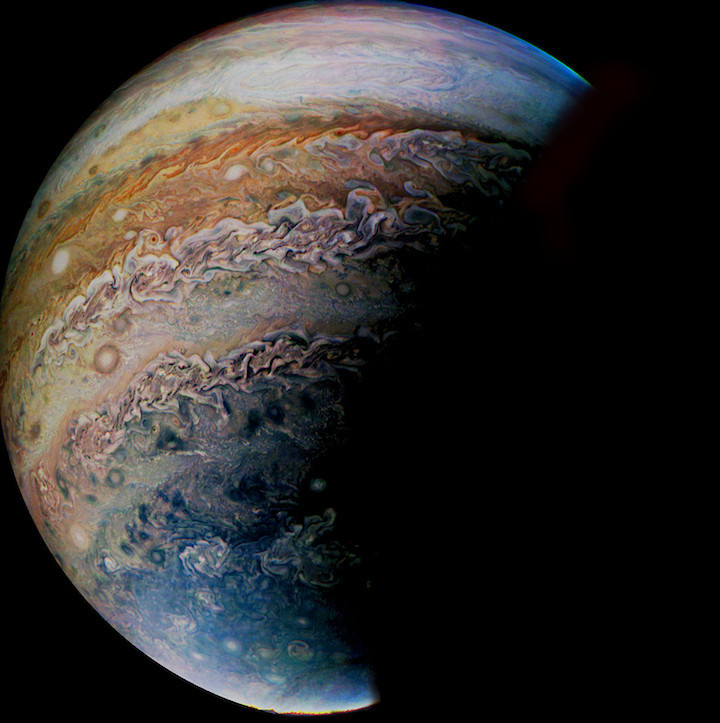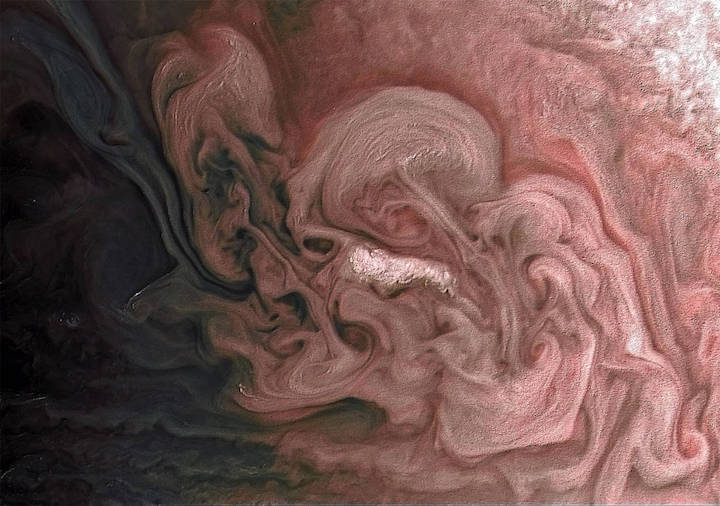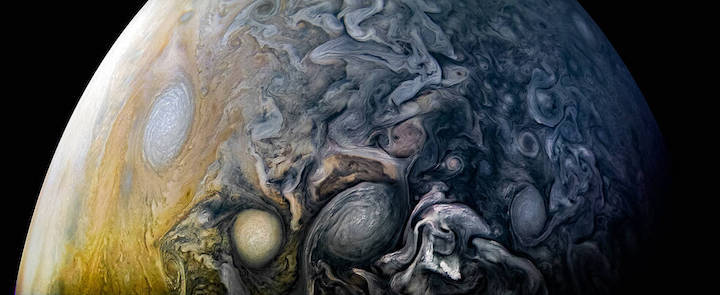In this animation the viewer is taken low over Jupiter’s north pole to illustrate the 3-D aspects of the region’s central cyclone and the eight cyclones that encircle it. The movie utilizes imagery derived from data collected by the Jovian Infrared Auroral Mapper (JIRAM) instrument aboard NASA's Juno mission during its fourth pass over the massive planet. Infrared cameras are used to sense the temperature of Jupiter’s atmosphere and provide insight into how the powerful cyclones at Jupiter's poles work. In the animation, the yellow areas are warmer (or deeper into Jupiter’s atmosphere) and the dark areas are colder (or higher up in Jupiter’s atmosphere). In this picture the highest “brightness temperature” is around 260K (about -13°C) and the lowest around 190K (about -83°C). The “brightness temperature” is a measurement of the radiance, at 5 µm, traveling upward from the top of the atmosphere towards Juno, expressed in units of temperature.
Scientists working on NASA’s Juno mission to Jupiter shared a 3-D infrared movie depicting densely packed cyclones and anticyclones that permeate the planet’s polar regions, and the first detailed view of a dynamo, or engine, powering the magnetic field for any planet beyond Earth. Those are among the items unveiled during the European Geosciences Union General Assembly in Vienna, Austria, on Wednesday, April 11.
Juno mission scientists have taken data collected by the spacecraft’s Jovian InfraRed Auroral Mapper (JIRAM) instrument and generated the 3-D fly-around of the Jovian world’s north pole. Imaging in the infrared part of the spectrum, JIRAM captures light emerging from deep inside Jupiter equally well, night or day. The instrument probes the weather layer down to 30 to 45 miles (50 to 70 kilometers) below Jupiter's cloud tops. The imagery will help the team understand the forces at work in the animation – a north pole dominated by a central cyclone surrounded by eight circumpolar cyclones with diameters ranging from 2,500 to 2,900 miles (4,000 to 4,600 kilometers).
“Before Juno, we could only guess what Jupiter’s poles would look like,” said Alberto Adriani, Juno co-investigator from the Institute for Space Astrophysics and Planetology, Rome. “Now, with Juno flying over the poles at a close distance it permits the collection of infrared imagery on Jupiter’s polar weather patterns and its massive cyclones in unprecedented spatial resolution.”
NASA’s Juno mission has provided the first view of the dynamo, or engine, powering Jupiter's magnetic field. The new global portrait reveals unexpected irregularities and regions of surprising magnetic field intensity. Red areas show where magnetic field lines emerge from the planet, while blue areas show where they return. As Juno continues its mission, it will improve our understanding of Jupiter's complex magnetic environment.
Another Juno investigation discussed during the media briefing was the team’s latest pursuit of the interior composition of the gas giant. One of the biggest pieces in its discovery has been understanding how Jupiter’s deep interior rotates.
“Prior to Juno, we could not distinguish between extreme models of Jupiter’s interior rotation, which all fitted the data collected by Earth-based observations and other deep space missions,” said Tristan Guillot, a Juno co-investigator from the Université Côte d'Azur, Nice, France. “But Juno is different -- it orbits the planet from pole-to-pole and gets closer to Jupiter than any spacecraft ever before. Thanks to the amazing increase in accuracy brought by Juno’s gravity data, we have essentially solved the issue of how Jupiter’s interior rotates: The zones and belts that we see in the atmosphere rotating at different speeds extend to about 1,900 miles (3,000 kilometers).
“At this point, hydrogen becomes conductive enough to be dragged into near-uniform rotation by the planet’s powerful magnetic field.”
An infrared view of Jupiter’s North Pole. The movie utilizes imagery derived from data collected by the Jovian Infrared Auroral Mapper (JIRAM) instrument aboard NASA's Juno mission. The images were obtained during Juno’s fourth pass over Jupiter. Infrared cameras are used to sense the temperature of Jupiter’s atmosphere and provide insight into how the powerful cyclones at Jupiter's poles work. In the animation, the yellow areas are warmer (or deeper into Jupiter’s atmosphere) and the dark areas are colder (or higher up in Jupiter’s atmosphere). In this picture the highest “brightness temperature” is around 260K (about -13°C) and the lowest around 190K (about -83°C). The “brightness temperature” is a measurement of the radiance, at 5 µm, traveling upward from the top of the atmosphere towards Juno, expressed in units of temperature.
The same data used to analyze Jupiter’s rotation contain information on the planet’s interior structure and composition. Not knowing the interior rotation was severely limiting the ability to probe the deep interior. “Now our work can really begin in earnest -- determining the interior composition of the solar system’s largest planet,” said Guillot.
At the meeting, the mission’s deputy-principal investigator, Jack Connerney of the Space Research Corporation, Annapolis, Maryland, presented the first detailed view of the dynamo, or engine, powering the magnetic field of Jupiter.
Connerney and colleagues produced the new magnetic field model from measurements made during eight orbits of Jupiter. From those, they derived maps of the magnetic field at the surface and in the region below the surface where the dynamo is thought to originate. Because Jupiter is a gas giant, “surface” is defined as one Jupiter radius, which is about 44,400 miles (71,450 kilometers).
These maps provide an extraordinary advancement in current knowledge and will guide the science team in planning the spacecraft’s remaining observations.
“We’re finding that Jupiter’s magnetic field is unlike anything previously imagined,” said Connerney. “Juno’s investigations of the magnetic environment at Jupiter represent the beginning of a new era in the studies of planetary dynamos.”
The map Connerney’s team made of the dynamo source region revealed unexpected irregularities, regions of surprising magnetic field intensity, and that Jupiter’s magnetic field is more complex in the northern hemisphere than in the southern hemisphere. About halfway between the equator and the north pole lies an area where the magnetic field is intense and positive. It is flanked by areas that are less intense and negative. In the southern hemisphere, however, the magnetic field is consistently negative, becoming more and more intense from the equator to the pole.
The researchers are still figuring out why they would see these differences in a rotating planet that’s generally thought of as more-or-less fluid.
“Juno is only about one third the way through its planed mapping mission and already we are beginning to discover hints on how Jupiter’s dynamo works,” said Connerney. “The team is really anxious to see the data from our remaining orbits.”
Juno has logged nearly 122 million miles (200 million kilometers) to complete those 11 science passes since entering Jupiter's orbit on July 4, 2016. Juno's 12th science pass will be on May 24.
NASA's Jet Propulsion Laboratory, Pasadena, California, manages the Juno mission for the principal investigator, Scott Bolton, of the Southwest Research Institute in San Antonio. Juno is part of NASA's New Frontiers Program, which is managed at NASA's Marshall Space Flight Center in Huntsville, Alabama, for NASA's Science Mission Directorate. The Italian Space Agency (ASI), contributed two instruments, a Ka-band frequency translator (KaT) and the Jovian Infrared Auroral Mapper (JIRAM). Lockheed Martin Space, Denver, built the spacecraft.
Quelle: NASA
---
Update: 24.04.2018
.
Jupiter’s Great Red Spot, Spotted
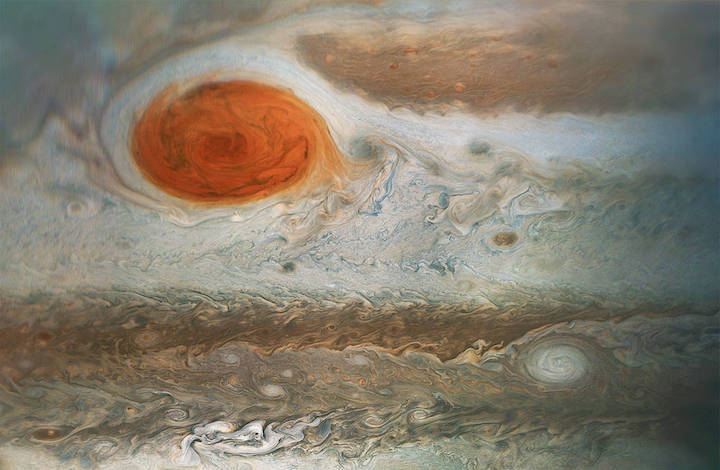
This image of Jupiter’s iconic Great Red Spot and surrounding turbulent zones was captured by NASA’s Juno spacecraft.
The color-enhanced image is a combination of three separate images taken on April 1 between 3:09 a.m. PDT (6:09 a.m. EDT) and 3:24 a.m. PDT (6:24 a.m. EDT), as Juno performed its 12thclose flyby of Jupiter. At the time the images were taken, the spacecraft was 15,379 miles (24,749 kilometers) to 30,633 miles (49,299 kilometers) from the tops of the clouds of the planet at a southern latitude spanning 43.2 to 62.1 degrees.
Citizen scientists Gerald Eichstädt and Seán Doran processed this image using data from the JunoCam imager.
Quelle: NASA
---
Update: 11.05.2018
.
Jupiter’s Dynamic Atmosphere
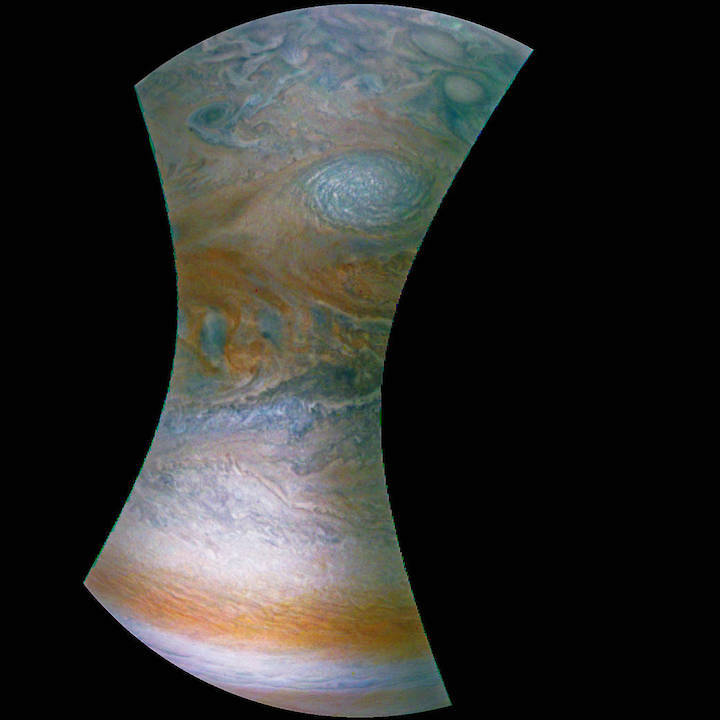
This image captures the dynamic nature of Jupiter's northern temperate belt. The view reveals a white, oval-shaped anticyclonic storm called WS-4.
NASA’s Juno spacecraft took this color-enhanced image on April 1 at 2:38 a.m. PST (5:38 a.m. EST) during its 12th close flyby of the gas giant planet. At the time, the spacecraft was 4,087 miles (6,577 kilometers) from the tops of Jupiter’s clouds at 35.6 degrees north latitude.
This image was created by citizen scientist Emma Walimaki using data from the JunoCam imager on NASA’s Juno spacecraft.
Quelle: NASA
---
Update: 13.05.2018
.
“New views of Jupiter” showcases swirling clouds on giant planet
Members of NASA’s Juno mission team, some of the world’s leading observers of Jupiter, and citizen scientists from across the globe will attend a workshop ‘New Views of Jupiter: Pro-Am Collaborations during and beyond the NASA Juno Mission’ at the Royal Astronomical Society in London on 10-11 May.
JunoCam images presented at the meeting by citizen scientists Gerald Eichstädt and Seán Doran include an animation showing the evolution of swirling features in the giant planet’s atmosphere and a composite image of Jupiter’s cloud tops.
Gerald Eichstädt, a mathematician working as a software professional, has taken two images from JunoCam and reprojected them to the same vantage point to enable a direct comparison between the images and show the subtle motions within the atmosphere. By modelling the movement of individual pixels in the images, he has created an animation that extrapolates the swirling evolution of the vortices in the atmosphere.
Eichstädt explains: “This animation represents a ‘feasibility test’. Building on this initial work, we can add in more variables that will give us a more detailed description and physical understanding of Jupiter’s atmosphere.”
Seán Doran, in collaboration with Eichstädt, has created a new composite image of Jupiter as seen by Juno as it swung away from Jupiter’s south pole on 1st April 2018. Because Jupiter was larger than JunoCam’s field of view when the main portion of the image was taken, Eichstädt rendered four other images to the same viewing geometry to reconstruct a mosaic of the whole planet. Doran then processed the composite image to balance and blend the overlapping components, sharpen the contrast, and fill gaps.
“It’s something of a labour of love that requires plenty of patience,” says Doran. “Energetic particles impact the CCD and produce bright specks. Once I’d finished the processing, I needed to go through and repair a couple hundred of these bright pixels.”
Leigh Fletcher of the University of Leicester, who has co-organised the workshop with the support of Europlanet 2020 Research Infrastructure, says: “The contribution of the Earth-based support campaign to the Juno mission, both professional and amateur, has proven to be invaluable in filling the spatial, temporal, and spectral gaps in Juno’s capabilities. Now two years into the mission, we’ve seen some tremendous new science emerging from this collaboration, and breath-taking imagery of Jupiter’s complex atmosphere that would not have been possible without the talented army of citizen scientists that have been working alongside the JunoCam team every step of the way.”
“The amateur observations are key to detecting and rapid changes of the atmospheric properties in time on shorter time scales than possible from the professional community, whose resources are shared among many different programs. Thus, they not only measure changes between Juno’s close encounters with Jupiter, but they also provide a means to anticipate changes that might influence how future observations can be interpreted, and they could even influence decisions on Juno’s observing strategy in the case of unexpected phenomena,“ says Glenn Orton of Jet Propulsion Laboratory, California Institute of Technology, who is the Juno science team member in charge of coordinating Earth-based observations to extend and enhance the science return from Juno’s investigation of Jupiter and its magnetosphere.
John Rogers of the British Astronomical Association, who co-organised the workshop says: “Many of these people have known each other for years by email addresses and social media alone, so to have them all in one place will be an incredibly special opportunity, fostering new collaborations and cementing existing friendships.”
Follow updates for the workshop through the hashtag #RASJuno on social media.
Images
This composite image of Jupiter was taken as Juno swung away from Jupiter’s south pole following its closest approach to Jupiter on 1st April 2018. JunoCam took the central part of the image when Juno was 24,749.4 km above Jupiter’s cloud tops. Jupiter was larger than JunoCam’s horizontal field of view of about 58 degrees. JunoCam took additional images from other perspectives and distances along Juno’s trajectory. Those additional images have been reprojected as if they would have been taken from the same vantage point. Credit: NASA / SwRI / MSSS / Gerald Eichstädt / Seán Doran.

http://www.europlanet-eu.org/wp-content/uploads/2018/05/PJ12_GRS_reprojection3_GE_2k.jpg
Two JunoCam images, taken around 8 minutes 41 seconds apart, have been re-projected to the same vantage point, cropped, and enhanced in a context sensitive way. A subtle motion can be perceived through a simple “blink comparison”. Image credit: NASA / JPL / SwRI / MSSS / Gerald Eichstädt.

http://junocam.pictures/gerald/talks/europlanet_london_20180510/summary_v01/PJ12_JNCE_2018091_12C00099_V01_099_100_Hipass00_blink.gif
Animation extrapolating the movement of the clouds from JunoCam imagery taken on 1st April 2018. Image credit: NASA / JPL / SwRI / MSSS / Gerald Eichstädt.
http://junocam.pictures/gerald/talks/europlanet_london_20180510/summary_v01/PJ12_099_s2_100_s2_10000samples_mode2_morph.mp4
The animation was created from imagery taken during Juno’s swing-by of Jupiter on 1st April 2018. The white box on the image of Jupiter (left) shows the location of the clouds in the zoomed in area (top right). A filter was applied (bottom right) to enhance the contrast. Image credit: NASA / JPL / SwRI / MSSS / Gerald Eichstädt.

http://www.europlanet-eu.org/wp-content/uploads/2018/05/Clouds_animation.jpg
Quelle: europlanet


